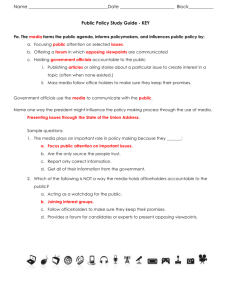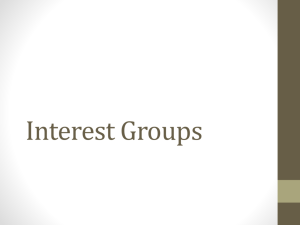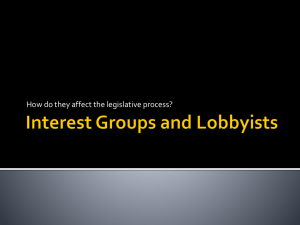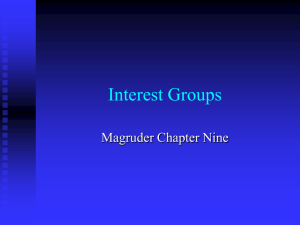Chapter 9
advertisement
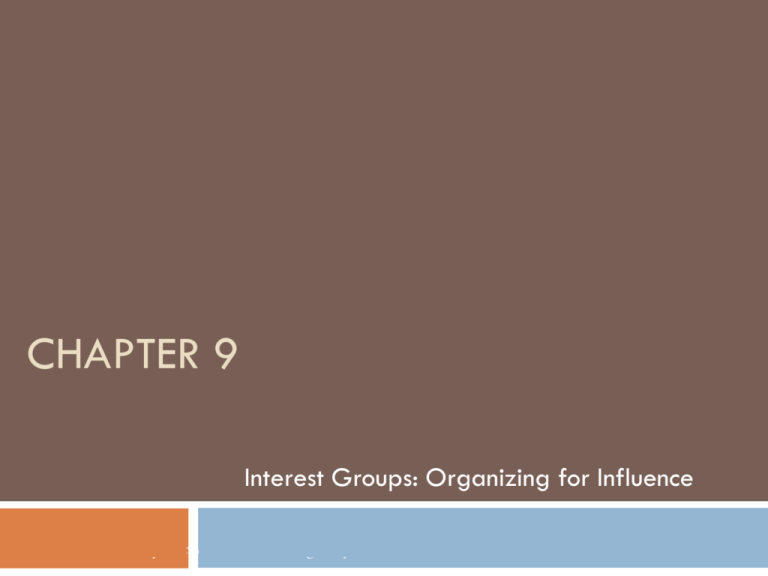
CHAPTER 9 Interest Groups: Organizing for Influence Presentation by Eric Miller, Blinn College, Bryan, Texas. E. E. Schattschneider The flaw in the pluralist heaven is that the heavenly chorus sings with a strong upper-class bias. The Interest Group System The interest-group system includes all interests that are organized and seek political goals Interest group = a faction Typical Interest group functions Supporting candidates for public office Working to influence legislators and policymakers Promoting public policies The difference between political parties and the typical interest group the party addresses a broad range of issues The Interest Group System James Madison the source of most interest groups or factions is the unequal distribution of property Worried that gov. would be dominated by groups but recognized that a free society must allow the advocacy of selfinterest- Federalist no. 10 The Interest Group System Reasons for so many groups: American tradition of free association the wide diversity of interests that exist in America America’s federal system- multiple gov. entities The Interest Group System Alexis de Tocqueville describes America as “a nation of joiners” Citizens of the U.S. are more actively involved in interest groups and community causes than other nations Interest group activity is basic to democracy because it promotes the concern of various interests in society The Interest Group System Economic Groups The organizational edge: economic groups versus citizens’ groups Private (Individual) goods vs. collective (public) goods Private- Material Incentive i.e. higher wages, lower taxes, subsidies Public- clean air & water, protection of individual rights The free rider problem- non-members get these benefits for free The size factor: business groups smaller and more efficient The Interest Group System Economic Groups Types of Economic Groups Business Groups the most fully organized Labor Groups Agricultural Groups Professional Groups Percentage Union Members, by Sector and Industry 10 The Interest Group System Citizens’ Groups Purposive Incentives The satisfaction of contributing to a worthy goal or purpose Collective (Public) Goods cannot be selectively denied to individuals The air we breathe = collective good The Free-Rider Problem individuals get the benefit without belonging to the group to overcome this groups have created benefits for members The Interest Group System Citizens’ Groups Types of Citizens’ Groups Public-Interest Groups- NAACP Single-Issue Groups- NRA Ideological Groups- MoveOn concerned with a wide number of issues 13 The Interest Group System A Special Category of Interest Group: Governments States, cities, and other governmental units in the U.S. lobby heavily Foreign governments are prohibited from certain lobbying activities Pressure through their embassies with paid lobbyists in Washington Inside Lobbying: Seeking Influence Through Official Contacts Acquiring Access to Officials Policy support- Based on providing useful and persuasive information to key officials Campaign Contributions- Money is key element—amount contributed is staggering K Street- 20,000+ lobbyists in DC Regulated by: Lobbying Disclosure Act-1995 &Honest Leadership & Open Government Act-2007 Requires lobbyists to register and file detailed reports of activities “Revolving door” – Capitol Hill to K Street Some top officials are former lobbyists Total Spending on Lobbying of Federal Government 17 Inside Lobbying: Seeking Influence Through Official Contacts Lobbying Congress Most significant resource that groups offer candidates = $$$ Lobbying Executive Agencies Targets include POTUS & presidential staff Top officials in executive agencies “Agency capture”- over time the agencies tend to favor the industries they are supposed to regulate- Lobbying the Courts Initiating lawsuits- i.e. ACLU Lobbying for certain judges to be appointed to the bench Inside Lobbying: Seeking Influence Through Official Contacts Webs of Influence: Groups in the Policy Process Iron Triangles Small and informal but stable set of bureaucrats, legislators, and lobbyists who are concerned with promoting a particular interest Inside Lobbying: Seeking Influence Through Official Contacts Webs of Influence: Groups in the Policy Process Issue Networks Informal grouping of officials, lobbyists, and policy specialists who are brought together temporarily by their shared interest in a particular policy problem Generally more frequent but less stable than iron triangles Members of an issue network may change as the issue develops Once the issue is settled, the network disolves Outside Lobbying: Seeking Influence Through Public Pressure Constituency Advocacy: Grassroots Lobbying Grass-roots Members lobbying = pressure from constituents of the public try to get lawmakers’ attention AARP largest Difficult citizen group- over 30 million to assess influence Outside Lobbying: Seeking Influence Through Public Pressure Electoral Action: Votes and PAC Money PACs Tend to contribute money to incumbents 4000+ PACs funneling a group’s election contributions contributions limited to $10,000 per candidate for each election Most PACs associated with business 8x as much to incumbents Amount of influence? Too much? vs. right to be heard Citizens United v. FEC (2010) 1st Amendment issue Percentage of PACS by Category The Group System: Indispensable but Biased The Contribution of Groups to Self-Government: Pluralism Serving the “public interest”? Flaws in Pluralism: Interest-Group Liberalism and Economic Bias The tendency of officials to support demands of the interest groups Liberal- the habit of using government to promote group interests Neither party is “conservative” in the sense of being reluctant to use gov. power to promote groups Not equally representative Organization is an unequally distributed resource Economic groups are the most highly organized Nearly 2/3 of all lobbying groups are business related The Group System: Indispensable but Biased A Madisonian Dilemma Madison’s solution to the problem of factions actually contributes to the problem by the fragmentation of authority among policymakers thereby providing more groups more opportunities to get their way Federalist #10- A free society must allow pursuit of self- interest Checks and balances work to protect rights, but also exaggerate influence of minorities Groups can wield too much influence over individual policies or agencies States in the Nation




